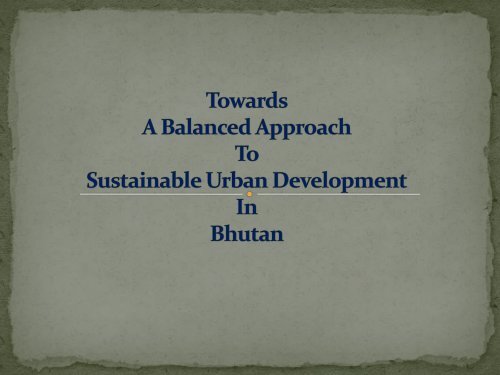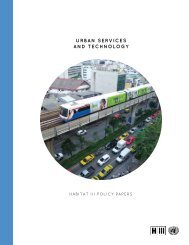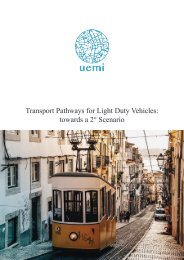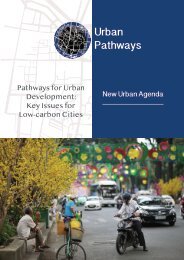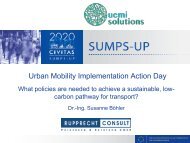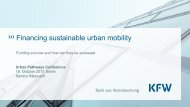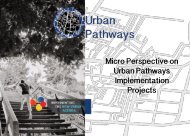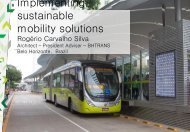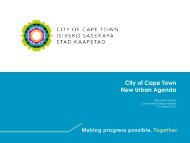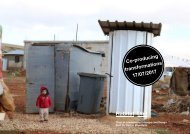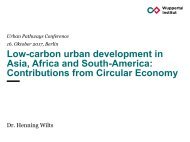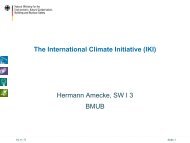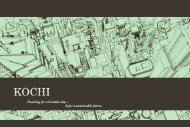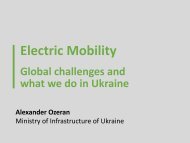Bhutan_pdf
You also want an ePaper? Increase the reach of your titles
YUMPU automatically turns print PDFs into web optimized ePapers that Google loves.
RURAL AND URBAN SETTLEMENT
Architecture
Culture
u BHUTAN has an area of 38,394 square kilometers located in<br />
eastern Himalayas, surrounded by China in the North and South<br />
by India.<br />
u Elevation ranges from 200 to 7000 meters resulting in diverse<br />
climatic conditions and biodiversity.<br />
u Administratively the country is divided into 20 districts and 205<br />
blocks<br />
u Population and Housing Census of <strong>Bhutan</strong> (PHCB) <strong>Bhutan</strong> has<br />
population increased from 634,982 in 2005 to 757,042 in 2015<br />
u <strong>Bhutan</strong> is going through the 11 th five year plan period which started<br />
in 1961<br />
u Today 30% of population lives in towns as against 15% in 1999<br />
u In terms of urbanization 65% of population lives in western region
Basic Facts<br />
u<br />
56% of <strong>Bhutan</strong>’s population are agriculturist accounting<br />
for 16.8% of GDP.<br />
u<br />
u<br />
u<br />
u<br />
Country’s fragile ecology and geography - a challenge to<br />
urbanization<br />
<strong>Bhutan</strong> has urbanized 31% with sharp regional disparity<br />
in terms of settlement<br />
Current urbanization growth is 7.3% as compared to<br />
1.28% for total population. West by 11%<br />
Given the harsh geo-physical conditions the spatial study<br />
shows that land occupied currently for settlement is<br />
about 1% of the total 38,394 square kms
Objectives<br />
To balance Rapid Urbanization with Preservation of country’s Fragile Ecosystem;<br />
- the <strong>Bhutan</strong> National Urbanization Strategy (BNUS) was adopted in<br />
2008. The BNUS:<br />
u Promotes different types of settlements with an integrated approach to<br />
planning and development. The BNUS :<br />
u Ensures Preservation of Environment, Tradition, Culture and its Sacred<br />
structures, unique Architecture, and conservation of Ecology<br />
u Mandates Safe and Disaster Resilient Settlements - with housing for all<br />
u Identifies potential settlement areas – Land, Connectivity & access, Water<br />
availability the Protected and Restricted / Sensitive areas<br />
u Recommends supporting Policies, Institutional and Regulatory frameworks<br />
to implement the National Human Settlement Policy (NHSP)
Guiding Principles:<br />
u The GNH principles that seek for a balanced approach to enhancing<br />
Economic development, Environment conservation, Cultural<br />
preservation and good Governance<br />
u The concept of regionally balanced and equitable development with<br />
emphasis of population growth and movement (NHSP)<br />
u Disaster Risk Reduction and Management Policy. <strong>Bhutan</strong><br />
susceptible to GLOF, Floods, Landslides and seismic hazards.<br />
u Mainstream X-cutting issues on Gender, Special needs, Poverty,<br />
Environment and Climate change<br />
u Relevant to Prevailing and Emerging development Trends and<br />
Issues
URBAN PLANNING & DEVELOPMENT DIVISION<br />
6 TH ENGINEERING CONFERENCE
- Drying of Water sources e.g, Mongar & Damphu in<br />
Tsirang (are severely hit).<br />
- Land slides, Flash floods and storms because of<br />
intense and extreme weather events.<br />
URBAN PLANNING & DEVELOPMENT DIVISION<br />
6 TH ENGINEERING CONFERENCE
u<br />
<strong>Bhutan</strong> Vision Doc 2020: A Vision for Peace, Prosperity<br />
and Happiness.<br />
u Strategy for Gross National Happiness 2010.<br />
u<br />
National Human Settlement Policy (NHSP)<br />
u Comprehensive National Development Plan (CNDP -<br />
Under preparation)<br />
u <strong>Bhutan</strong> National Urbanization Strategy (BNUS 2008).<br />
u<br />
u<br />
National Human Settlement Strategy.<br />
….all these policies aim to promote Settlements that are<br />
Environmentally Sustainable, Culturally Vibrant,<br />
Economically Strong, and Highly Livable.
Of the few Policies the NHSP, broadly covers both<br />
Urban and Rural settlements. And it was envisaged<br />
that by 2020, <strong>Bhutan</strong> would be 50% Urbanized<br />
Vision<br />
Development of Highly Live-able Human Settlement<br />
Mission<br />
To provide a framework for Planning and<br />
Development of Environmentally Sustainable,<br />
Culturally and Economically vibrant and Disaster<br />
Resilient Human Settlements.
Strategy to Balance Urbanization<br />
uHuman Settlement Strategy to focus on Regional Growth<br />
Policy.<br />
- The <strong>Bhutan</strong> National Urbanization Strategy (BNUS)<br />
uPolicies therefore adopted to respond to economic<br />
compulsion that give rise to rapid rural-urban migration<br />
uFocus on expansion of existing centers vice creation of new &<br />
provide basic live-able requirements<br />
uBNUS looks into improving quality of urban design and<br />
planning – with critical focus on comprehensive land use for<br />
provision of infrastructural amenities
uSpecific regulations to capture Peri-urban and Semi-urban<br />
areas which are fast transitioning from rural to urban<br />
character<br />
[generally the fast growing areas –do not get adequate basic<br />
amenities and services such as water supply, electricity and road<br />
accessibility let alone the more urban comforts of leisure spaces,<br />
pedestrian walkways, differently abled needs]<br />
uPut in place (where necessary) / adopt available (if any)<br />
legislation and national strategies<br />
uStrengthen institutional and legal framework for promotion<br />
of inclusive and participatory system of planning and<br />
development of a live-able human settlements
uEducation and Health infrastructure taken closer to rural<br />
population; Rural Connectivity enhanced<br />
uTo allow income generation efforts were made to<br />
modernize the agriculture and horticultural sector<br />
uIn terms of settlement <strong>Bhutan</strong> declared autonomous<br />
municipalities and satellite towns in each of twenty<br />
districts<br />
uTwo Regional Hubs – address issues of R-U migration
uBalanced Regional Development by identifying<br />
regional growth centers in the eastern and central<br />
regions of the country.<br />
uRural-Urban Integration.<br />
uNational Urban System: Hierarchy of urban<br />
settlements forming spatial framework through<br />
network of cities, towns and village centers.<br />
u Financial priorities to the regional centers.
uEnforcement of Environmental Protection Policies.<br />
(Benefits of Farmers and Communities are not compromised)<br />
uPreservation of Culture and Heritage.<br />
(Two towns viz Bumtha and Trashi Yangtse to be<br />
maintained as Unique Heritage towns)<br />
uInstitutionalizing Community Participation in<br />
Urban Planning and Development.<br />
uInstitutional and Capacity Building.
u Thromde (Municipality) as a Local<br />
Government by Local Government Act 2009.<br />
u Declaration of 20 District Municipalities and<br />
20 Satellite towns.<br />
u Municipal Finance Policy in place to improve<br />
financial autonomy of the Municipalities.
u Spatial Planning Act completed and is due<br />
for submission to Cabinet for endorsement<br />
and for onward submission to Parliament.<br />
u Mandatory requirement to carry out SEA<br />
(Strategic Environmental Assessment) and<br />
EIA (Environmental Impact Assessment) for<br />
major projects.<br />
u Low Emission Development Strategy for<br />
Urban and Rural Areas of <strong>Bhutan</strong>
u Revision of Land Pooling/Land Readjustment<br />
Regulations to address the emerging trends<br />
of urban planning and its implementation<br />
completed.<br />
u Revision of Building Regulations completed.
u Three Tier Spatial Planning Frame Work:<br />
National, Regional and Local Spatial Plans.<br />
u Incentives for Protected Zones issued as<br />
Directives by the Government to implement<br />
areas such as<br />
u river buffer, open spaces, Environmentally<br />
Sensitive areas, buffer for culture and<br />
heritage structures etc identified in the<br />
urban development plans.
u Establishment of Planning Process to ensure<br />
proper planning and informed decision<br />
making.
u Preparation of TWO Valley Development Plans<br />
integrating Rural and Urban Areas which are<br />
under implementation.<br />
u (Sharing of resources and facilitating rural and<br />
urban authorities to work together)<br />
u Two Regional Hubs (Education hub in East and<br />
Commercial Hub in central South)
PARO VALLEY<br />
URBAN PARO<br />
RURAL PARO
An Approach – facilitating the stakeholders and affected<br />
Landed Property Owners to Participate and own the<br />
Preparation of their Local Area Plans<br />
Percentage of property contribution range from 15 to 30<br />
percent. Beyond this was found technically inefficient<br />
Allows spaces for provision of common basic amenities<br />
such as water supply, power & sewer lines, building set<br />
backs for logistical and emergency accessibility - for<br />
firefighters during fire accidents
Toward a balanced approach to sustainable urban<br />
development
Design boundary adjustment proposal<br />
Samarzingk<br />
ha<br />
Include this parcel of<br />
land<br />
Include<br />
River<br />
Expressway<br />
Site<br />
Design<br />
boundary<br />
Include the traditional<br />
house<br />
Include<br />
Bazam
Conceptual View from West
Conceptual close up view from the East
Conceptual view of the OAT, Walkway & Side Entrance
HOPE OUR DREAMS COME TRUE<br />
SOONER


